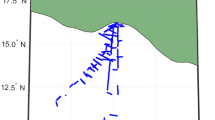Abstract
Frictional torque is an important mean for momentum exchange between the atmosphere and earth, and significantly influences the variation in atmospheric angular momentum. Using NCEP-NCAR reanalysis data for the period 1948–2011, we examined the spatial and temporal patterns of frictional torque. It was found that the globally integrated frictional torque turned from positive to negative in 1972, suggesting that angular momentum was transferred from the earth to the atmosphere before 1972, but from the atmosphere to the earth thereafter. The global frictional torque steadily declined from 1948 to 1994, but has been increasing since 1995. It was also found that the global frictional torque is mainly determined by the wind systems in the mid and low latitudes of the Southern Hemisphere (SH), where large changes in frictional torque occurred during the study period. Westerly wind increased continuously in the midlatitudes after 1948, while easterly wind decreased in the tropics of the SH after the 1980s.
Similar content being viewed by others
References
Arpe, K., and S. K. Esbensen, 1989: Surface stresses and latent heat fluxes over oceans in short range forecasts: Their annual and interannual variability and comparison with climatological estimates. Ann. Meteor., 1, 128–130.
Brázdil, R., K. Chromá, P. Dobrovolný, et al., 2009: Climate fluctuations in the Czech Republic during the period 1961–2005. Int. J. Climatol., 1, 223–242.
De Viron, O., and V. Dehant, 1999: Earth’s rotation and high frequency equatorial angular momentum budget of the atmosphere. Surv. Geophys., 1, 441–462.
De Viron, O., S. L. Marcus, and J. O. Dickey, 2001: Atmospheric torques during the winter of 1989: Impact of ENSO and NAO positive phases. Geophys. Res. Lett., 1, 1985–1988.
Driscoll, S., 2010: The earth’s atmospheric angular momentum budget and its representation in reanalysis observation datasets and climate models. Master dissertation, University of Reading, England, UK, 74 pp.
Egger, J., and K.-P. Hoinka, 2002: Covariance analysis of the global atmospheric axial angular momentum budget. Mon. Wea. Rev., 1, 1063–1070.
Egger, J., and K. Weickmann, 2007: Latitude-height structure of the atmospheric angular momentum cycle associated with the Madden–Julian oscillation. Mon. Wea. Rev., 1, 1564–1575.
Kalnay, E., M. Kanamitsu, R. Kistler, et al., 1996: The NCEP/NCAR 40-year reanalysis project. Bull. Amer. Meteor. Soc., 1, 437–471.
Li Jianping and Zeng Qingcun, 2005: A new monsoon index, its interannual variability and relation with monsoon precipitation. Climatic Environ. Res., 1, 351–365. (in Chinese)
Madden, R. A., and P. Speth, 1995: Estimates of atmospheric angular momentum, friction, and mountain torques during 1987–1988. J. Atmos. Sci., 1, 3681–3694.
McVicar, T. R., T. G. Van Niel, L. T. Li, et al., 2008: Wind speed climatology and trends for Australia, 1975–2006: Capturing the stilling phenomenon and comparison with near-surface reanalysis output. Geophys. Res. Lett., 35, L20403.
Oort, A. H., 1989: Angular momentum cycle in the atmosphere-ocean-solid earth system. Bull. Amer. Meteor. Soc., 1, 1231–1242.
Peixoto, J. P., and A. H. Oort, 1992: Physics of Climate. American Institute of Physics, 241–269.
Ponte, R. M., and R. D. Rosen, 1999: Torques responsible for evolution of atmospheric angular momentum during the 1982–83 El Ni˜no. J. Atmos. Sci., 1, 3457–3462.
Pryor, S. C., R. J. Barthelmie, D. T. Young, et al., 2009: Wind speed trends over the contiguous United States. J. Geophys. Res., 114, D14105.
Pu Yukang, 1994: Basic of the Atmospheric Circulation. China Meteorological Press, Beijing, 57–70.
Vautard, R., J. Cattiaux, P. Yiou, et al., 2010: Northern Hemisphere atmospheric stilling partly attributed to an increase in surface roughness. Nature Geosci., 1, 756–761.
Weickmann, K., 2003: Mountains, the global frictional torque, and the circulation over the Pacific–North American region. Mon. Wea. Rev., 1, 2608–2622.
Weickmann, K., and P. D. Sardeshmukh, 1994: The atmospheric angular momentum cycle associated with a Madden–Julian oscillation. J. Atmos. Sci., 1, 3194–3208.
Weickmann, K., G. N. Kiladis, and P. D. Sardeshmukh, 1997: The dynamics of intraseasonal atmospheric angular momentum oscillations. J. Atmos. Sci., 1, 1445–1461.
Yang Ping, Shi Wenjing, Xiao Ziniu, et al., 2014: Spatial and temporal variations of atmospheric angular momentum and its relation to the earth length of day. J. Meteor. Res., 1, 150–161.
Yang, X. M., Z. X. Li, Q. Feng, et al., 2012: The decreasing wind speed in southwestern China during 1969–2009, and possible causes. Quatern. Int., 263, 71–84.
Author information
Authors and Affiliations
Corresponding author
Additional information
Supported by the National (Key) Basic Research and Development (973) Program of China (2012CB957802).
Rights and permissions
About this article
Cite this article
Gong, H., Huang, M., Zhu, L. et al. Spatial and temporal variations of global frictional torque during the period 1948–2011. J Meteorol Res 30, 128–134 (2016). https://doi.org/10.1007/s13351-015-5066-y
Received:
Accepted:
Published:
Issue Date:
DOI: https://doi.org/10.1007/s13351-015-5066-y




